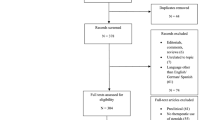Abstract
An easy, reproducible and semi-quantitative, non-radioactive method for the analysis of mRNA expression for various cytokines, (i.e., Interleukin (IL)-1β, IL-4, IL-6, tumor necrosis factor (TNF)-α, lymphotoxin (LT), transforming growth factor (TGF)-β, interferon (IFN)-γ and endothelin-1 (ET-1)) in cells from cerebrospinal fluid (CSF) and peripheral blood mononuclear cells (PBMC) has been established. By means of polymerase chain reaction primers that cover a splice junction, amplification of contaminating DNA was omitted. Densitometric scanning of ethidium bromide-stained agarose gels proved to be very sensitive for semiquantitative analysis of PCR products. Serial tenfold dilutions of cDNA revealed a log-linear regression from 106 to 102 cells under optimal cycle conditions. The intra- and inter-assay variability of the method was below 10%. With this assay, the cytokine expression pattern of as few as 104 mononuclear cells from blood or CSF was determined. This method made it possible to detect differences in the cytokine gene expression pattern of mononuclear cells from patients with different neurological diseases. CSF cells from 43 patients with various neurological diseases were analyzed. TNF-α, LT, and IL-1 mRNA were prominent in the CSF cells of most patients with bacterial meningitis. TNF-α, LT, IFN-γ and IL-6 mRNAs were detected in patients with active multiple sclerosis, whereas TNF-α, IL-6, and endothelin-1 mRNA expression was found frequently in patients with HIV encephalitis. Pro-inflammatory cytokines were rarely detected in CSF cells from patients with non-inflammatory diseases of the central nervous system. In blood mononuclear cells from patients with multiple sclerosis, TNF-α mRNA expression was associated with disease activity. The sensitivity, specificity, velocity and reliability of this assay considerably facilitates the analysis of cytokine production in mononuclear cells even in conditions where only a limited number of cells is available for analysis.
Similar content being viewed by others
References
Kennedy MK, Torrance DS, Picha KS, Mohler KM (1992) Analysis of cytokine mRNA expression in the central nervous system of mice with experimental autoimmune encephalomyelitis reveals that IL-10 mRNA expression correlates with recovery. J Immunol 149:2496–2505
Marini M, Avoni E, Hollemborg J, Mattoli S (1992) Cytokine mRNA profile and cell activation in bronchoalveolar lavage fluid from nonatopic patients with symptomatic asthma. Chest 102:661–669
Martinez OM, Krams SM, Sterneck M, et al (1992) Intragraft cytokine profile during human liver allograft rejection. Transplantation 53:449–456
Mohler KM, Butler LD (1991) Quantitation of cytokine mRNA levels utilizing the reverse transcriptase-polymerase chain reaction following primary antigen-specific sensitization in vivo. Mol Immunol 28:437–447
Yamamura M, Uyemura K, Deans RJ, et al (1991) Defining protective responses to pathogens: cytokine profiles in leprosy lesions. Science 254:277–279
Carding SR, Lu D, Bottomly K (1992) A polymerase chain reaction assay for the detection and quantitation of cytokine gene expression in small numbers of cells. J Immuno Methods 151:277–287
Kanangat S, Solomon A, Rouse BT (1992) Use of quantitative polymerase chain reaction to quantitate cytokine messenger RNA molecules. Mol Immunol 29:1229–1236
Yamamura M, Wang XH, Ohmen JD, et al (1992) Cytokine patterns of immunologically mediated tissue damage. J Immunol 149:1470–1475
Glazer AN, Peck K, Mathies RA (1990) A stable double-stranded DNA-ethidium homodimer complex: application to picogram fluorescence detection of DNA in agarose gels. Proc Natl Acad Sci, USA 87:3851–3855
Ribiero EA, Larcom LL, Miller DP (1989) Quantitative fluorescence of DNA-intercalated ethidium bromide on agarose gels. Anal Biochem 181:197–208
Singer-Sam J, Robinson MO, Bellve AR, Simon MI, Riggs AD (1990) Measurement by quantitative PCR of changes in HRPT, PGK-1, PGK-2, APRT, MTase and Zfy gene transcripts during mouse spermatogenesis. Nucleic Acids Res 18:1255–1259
Paludan K, Thestrup PK (1992) Use of the polymerase chain reaction in quantification of interleukin 8 mRNA in minute epidermal samples. J Invest Dermatol 99:830–835
Bloch W (1991) A biochemical perspective of the polymerase chain reaction. Biochemistry 30:2735–2747
Ehlers S, Mielke ME, Blankenstein T, Hahn H (1992) Kinetic analysis of cytokine gene expression in the livers of naive and immune mice infected withListeria monocytogenes. The immediate early phase in innate resistance and acquired immunity. J Immunol 149: 3016–3022
Ehrenreich H, Lange M, Near KA, et al (1992) Long-term monitoring of immunoreactive endothelin-1 and endothelin-3 in ventricular cerebrospinal plasma, and 24-h urine of patients with subarachnoid hemorrhage. Res Exp Med 192:257–268
Rappolee DA, Mark D, Banda MJ, Werb Z (1988) Wound macrophages express TGF-alpha and other growth factors in vivo: analysis by mRNA phenotyping. Science 241:708–710
Wang AM, Doyle MB, Mark DF (1989) Quantitation of mRNA by the polymerase chain reaction. Proc Natl Acad Sci, USA 86:9717–9721
Pallansch L, Beswick H, Talian J, Zelenka P (1990) Use of an RNA folding algorithm to choose regions for amplification by the polymerase chain reaction. Anal Biochem 185:57–62
Drouet C, Shakhov AN, Jongeneel CV (1991) Enhancers and transcription factors controlling the inducibility of the tumor necrosis factor-alpha promoter in primary macrophages. J Immunol 147:1694–1700
Goldfeld AE, Strominger JL, Doyle C (1991) Human tumor necrosis factor-alpha gene regulation in phorbol ester stimulated T and B cell lines. J Exp Med 174:73–81
Beutler B, Cerami A (1986) Cachectin and tumor necrosis factor as two sides of the same biological coin. Nature 320:584–588
Ehrenreich H, Rieckmann P, Sinowatz F, et al (1993) Potent stimulation of monocytic endothelin-1 production by HIV-1 glycoprotein 120. J Immunol 150:4601–4609
Rieckmann P, Albrecht M, Kitze B, et al (1994) Cytokine mRNA levels in mononuclear blood cells from patients with multiple sclerosis. Neurology 44:1523–1526
Author information
Authors and Affiliations
Rights and permissions
About this article
Cite this article
Rieckmann, P., Albrecht, M., Ehrenreich, H. et al. Semi-quantitative analysis of cytokine gene expression in blood and cerebrospinal fluid cells by reverse transcriptase polymerase chain reaction. Res. Exp. Med. 195, 17–29 (1995). https://doi.org/10.1007/BF02576770
Received:
Accepted:
Issue Date:
DOI: https://doi.org/10.1007/BF02576770




